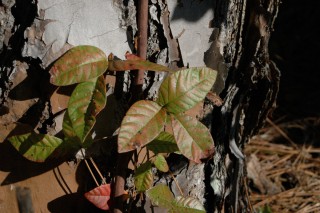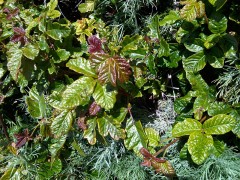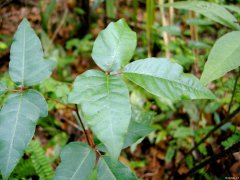When you’re a naturalist, even just an amateur one like me, there’s nothing better than to get out into the field. You don’t have to answer the phone, you’re not tied to the computer, you can wander, just walk where you’d like. You have the ability to stop for as long as you’d like, to check things out. And it’s usually a good idea to do so. Check things out, I mean. After all, if you don’t check things out, you might inadvertently run across this little nasty:
It is known as urushiol, and if you’re like at least 2/3 of humanity, the case of contact dermatitis you’ll get will make you wish you’d looked a little more closely before you’d leaned against that tree, or chased that toy car down by the canal:
Urushiol is a chemical that irritates the skin to varying degrees depending on individual sensitivity and amount of exposure. It is delivered to the skin through accidental contact with the oleoresin of plants like this:
or this:
The top picture is poison oak (Toxicodendron diversilobum), which I encountered all over my childhood and young adult stomping grounds in the West; the bottom picture is poison ivy (Toxicodendron radicans), which I know all too well from tromping around the natural areas of Palm Beach and Broward counties.
What is oleoresin, you ask? Well, it’s a naturally occurring plant product, which, as the name suggests, arises from the combination of an oil and a resin. It can occur either as a preparation (meaning someone combines the two on purpose) or, as in the case of the poisonous plants in Anacardiaceae, the very large plant family commonly called sumac, just au naturel. In case you’re curious, the sumac family has much more to offer us than dermatitis. It includes such delicious products as cashew, pistachio, and mango. Of course, you have to take the bad with the good. In addition to poisons oak and ivy, the sumac family has given Florida its #1 invasive exotic pest plant, Schinus terebinthifolius, the Brazilian Pepper. To which, by the way, I am also at least mildly allergic. I now don full gloves and long sleeves to rip out any seedlings I find on my property, after experiencing some tingling in any skin that made contact with the last cuttings I made…
Of course, many people have allergic reactions to cashews (I do not), or are allergic to the oleoresin in the skin and sap of the mango tree (I am). As long as you don’t touch the skin, or rub the sap on yourself, you should be OK even if, like me, you’re quite sensitive to urushiol. I have gotten the rash, though, when I peel mangoes myself, so I know not to do it!
I picked up my latest case of poison ivy during the recent North American Migration Count. Well, actually, it happened when I was pursuing my still-unidentified amphibians while simultaneously counting birds for the NAMC. You see, while I was chasing them down, I was not careful to watch where I was going, and before I knew it, I had the dread realization that I had run up against the dreaded leaves of three with my bare legs. Fortunately, I was near a bathroom, and I was able to wash off the poison before it spread through contact, and all I got was a little blemish on my left shin that never developed into anything too annoying.
Much nicer than my Easter escapade, in which my little lad threw his brand new toy car off the bridge, and his darn fool dad charged after to rescue it. I STILL have a visible mark on the inside of my right arm from that encounter, and a smudge on the outside of my hand. It’s been over 6 weeks!
The moral of this story: enjoy the outdoors, but watch your step!




